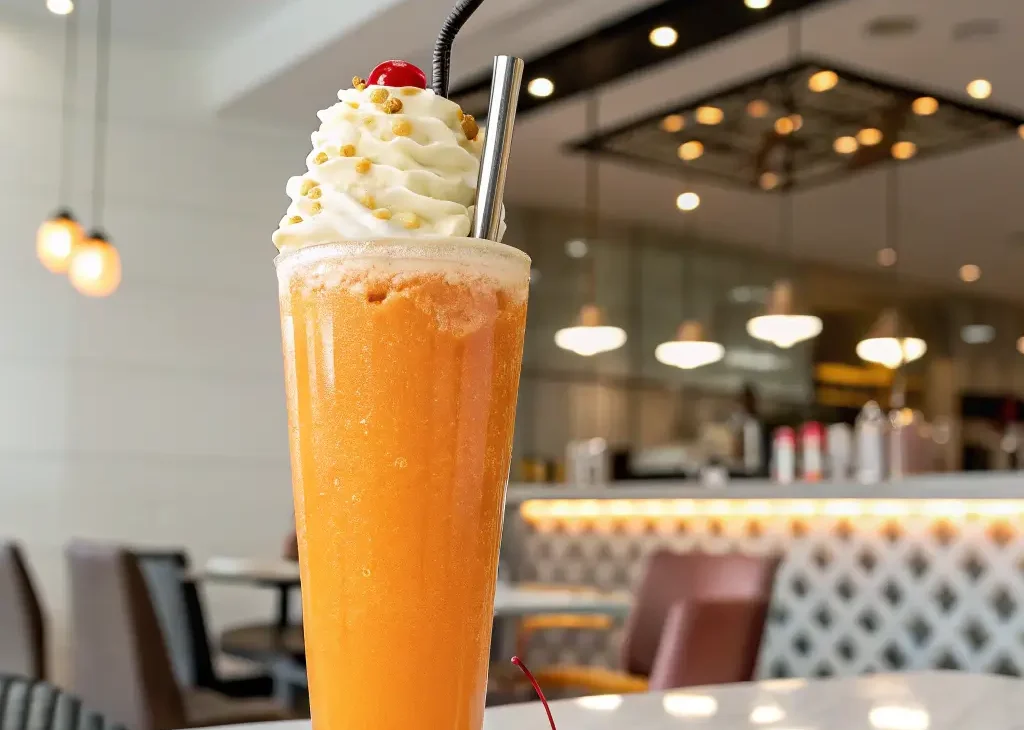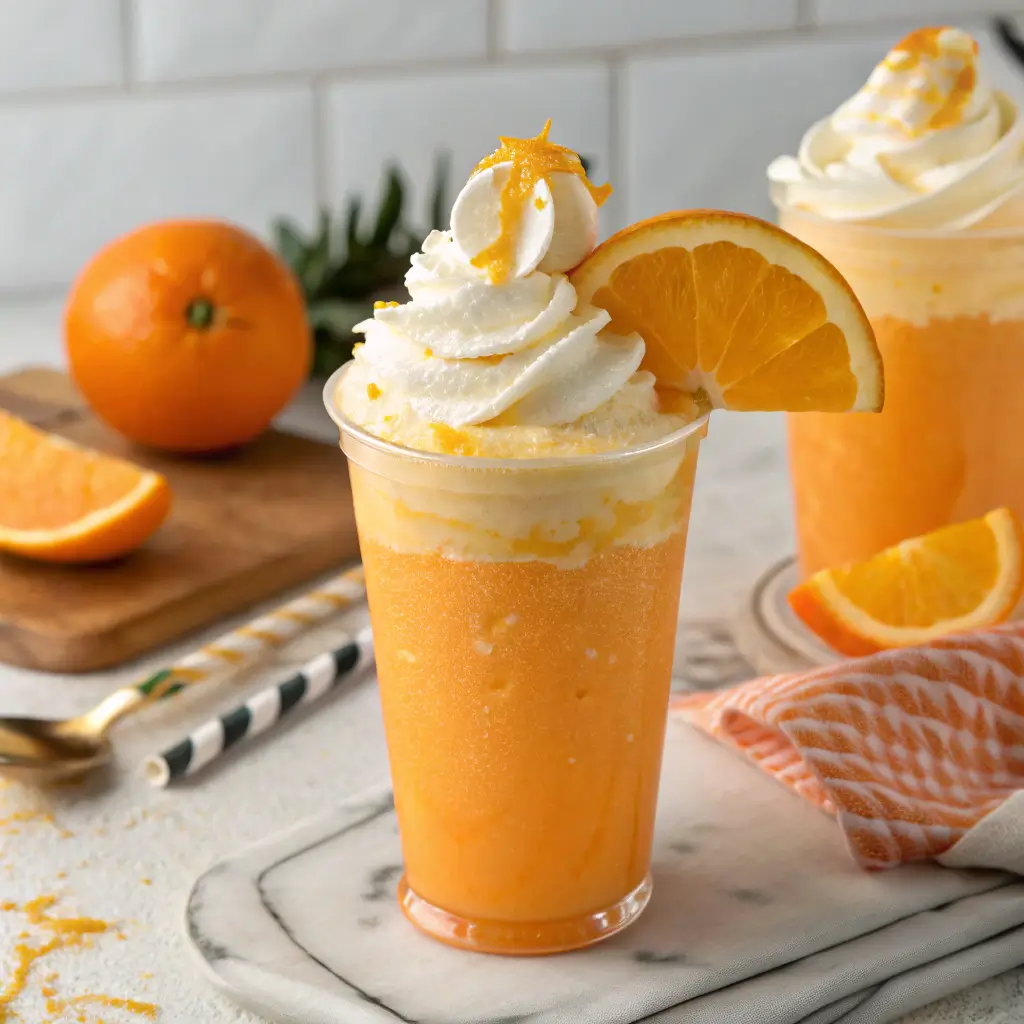The Ultimate Guide to Crafting the Perfect Orange Julius
Introduction: A Frothy Legacy
The creamy citrus sensation we know as Orange Julius has captivated taste buds for nearly a century. This iconic beverage masterfully blends the bright acidity of fresh oranges with the luxurious texture of whipped dairy, creating a drink that’s simultaneously refreshing and indulgent. What began as a simple orange juice stand innovation has evolved into a cultural phenomenon, with its distinctive flavor profile inspiring countless imitations and variations.
Unlike standard orange juice or ordinary smoothies, the Orange Julius occupies a unique category of its own – too thick to be juice, yet too light to be a milkshake. Its magic lies in the perfect equilibrium between tart and sweet, between liquid and foam. This guide will take you through every aspect of this beloved drink, from its historical roots to advanced preparation techniques that elevate it from good to extraordinary.

The Birth of an Icon: Historical Context
In the sunny climate of 1920s Los Angeles, entrepreneur Julius Freed opened a modest orange juice stand. The original concept was straightforward – fresh-squeezed citrus for health-conscious consumers. However, Freed’s business partner Bill Hamlin recognized an opportunity to enhance the drinking experience. By experimenting with dairy additions and aeration techniques, they developed the prototype for what would become their signature beverage.
The drink’s popularity surged when the partners introduced specialized mixing equipment that could consistently produce its characteristic frothy texture. Patrons were drawn to both the novel mouthfeel and the clever positioning of the drink as being easier on sensitive stomachs than plain orange juice. By the mid-20th century, the Orange Julius brand had become synonymous with mall culture, often positioned near food courts and movie theaters as a refreshing alternative to carbonated sodas.
Decoding the Orange Julius Experience
What distinguishes an authentic Orange Julius from ordinary orange drinks? Three key elements create its signature profile:
- Texture Architecture
The drink’s velvety consistency comes from a carefully balanced ratio of liquid to air. When properly prepared, it should have the drinkability of juice but the body of a light smoothie. This is achieved through:
- Precise blending techniques
- Optimal ingredient temperatures
- Strategic sequencing of additions
- Flavor Dynamics
The taste profile follows a specific progression:
- Initial bright citrus notes
- Mid-palate creamy richness
- Clean, slightly sweet finish
- Visual Appeal
A well-made Orange Julius displays:
- Consistent pale orange hue
- Stable foam crown
- Slow bubble dissipation
Crafting Perfection: The Complete Technique
Ingredient Selection
Citrus Component
- Use navel oranges for consistent sweetness
- Select fruit with smooth, thin skin for maximum juice yield
- Juice immediately before preparation for peak flavor
Dairy Elements
- Whole milk provides ideal fat content
- For richer versions, substitute half-and-half
- Ultra-pasteurized dairy blends more smoothly
Sweetening Agents
- Superfine sugar dissolves completely
- Simple syrup prevents graininess
- Alternative sweeteners require texture adjustments
Equipment Essentials
- Juicing Tools
- Manual reamer for small batches
- Electric juicer for volume preparation
- Blending Technology
- High-powered blender (minimum 1000W)
- Variable speed control
- Tamper for thick mixtures
- Temperature Management
- Pre-chilled stainless steel mixing cups
- Freezer-safe storage containers
Step-by-Step Master Method
Phase 1: Preparation
- Chill all components to 38°F
- Prepare simple syrup (1:1 ratio)
- Sanitize equipment surfaces
Phase 2: Juice Extraction
- Roll oranges to rupture juice sacs
- Halve along the equator
- Press with firm, even pressure
- Strain through 100-micron filter
Phase 3: Composition
- Combine liquids in blender carafe
- Add sweetener gradually
- Incorporate vanilla
- Pulse to integrate
Phase 4: Aeration
- Add ice in three stages
- Blend on high for 45 seconds
- Check foam consistency
- Adjust with additional ice if needed
Phase 5: Finishing
- Pour into chilled vessel
- Top with reserved foam
- Apply final garnish
Innovative Variations
Texture Modifications
Silken Edition
- Replace 25% milk with heavy cream
- Add 1/4 tsp lecithin
- Blend at lower speed
Cloud Version
- Incorporate pasteurized egg white
- Whip to soft peaks first
- Fold in gently
Crystal Clear
- Clarify juice through centrifugation
- Use milk powder for body
- Carbonate lightly
Flavor Explorations
Citrus Spectrum
- Blood orange for depth
- Yuzu for aromatic lift
- Meyer lemon for brightness
Spice Infusions
- Vanilla bean specks
- Toasted cinnamon
- Star anise syrup
Herbal Accents
- Basil-infused simple syrup
- Rosemary extract
- Lemongrass essence
Serving Innovations
Temperature Play
Frozen Sculpture
- Pour into chilled molds
- Flash freeze with liquid nitrogen
- Serve with citrus zest snow
Warm Interpretation
- Heat to 110°F
- Add honey instead of sugar
- Top with frothed milk
Interactive Presentations
Deconstructed Service
- Separate components in lab glassware
- Allow guest assembly
- Provide mixing tools
Tableside Preparation
- Cart with manual juicer
- Visible blending
- Custom sweetening options
The Science of Stability
Understanding the physical chemistry behind the Orange Julius helps maintain quality:
Foam Physics
- Protein matrix formation
- Bubble size distribution
- Drainage rate control
Emulsion Theory
- Fat globule dispersion
- Interface stabilization
- Coalescence prevention
Phase Behavior
- Ice crystal impact
- Sugar glass formation
- Viscosity gradients
Quality Assessment
Professional evaluation criteria:
Visual Inspection
- Foam persistence (>3 minutes)
- Color uniformity
- Surface reflectivity
Texture Analysis
- Mouth coating weight
- Bubble density
- Melt rate
Flavor Balance
- Sweet-acid ratio
- Vanilla detection threshold
- Aftertaste duration
Cultural Significance
The Orange Julius represents several American culinary themes:
Innovation Tradition
- Continuous recipe refinement
- Equipment development
- Format adaptation
Nostalgia Marketing
- Mall culture association
- Retro appeal
- Generational memory
Adaptability
- Dietary modifications
- Flavor variations
- Occasion versatility
Future Directions
Emerging trends in Orange Julius evolution:
Health-Conscious Versions
- Probiotic enrichment
- Vitamin fortification
- Botanical additives
Sustainability Focus
- Upcycled ingredients
- Zero-waste preparation
- Local sourcing
Technological Integration
- Smart blender programming
- Precision temperature control
- Automated customization

Conclusion: Mastering the Craft
Creating the perfect Orange Julius requires both art and science. By understanding its historical roots, mastering technical preparation methods, and experimenting with innovative variations, you can elevate this classic beverage to new heights. Whether recreating the traditional formula or developing your own signature version, the key lies in balancing four fundamental elements:
- Precision – Exact measurements and timing
- Quality – Premium, fresh ingredients
- Technique – Proper equipment handling
- Creativity – Willingness to experiment
The journey from simple orange juice to extraordinary Orange Julius mirrors the broader story of American culinary innovation – taking basic ingredients and transforming them through creativity and technical skill into something greater than the sum of its parts. As you embark on your own Orange Julius creations, remember that each variation adds to this ongoing story of delicious innovation.

